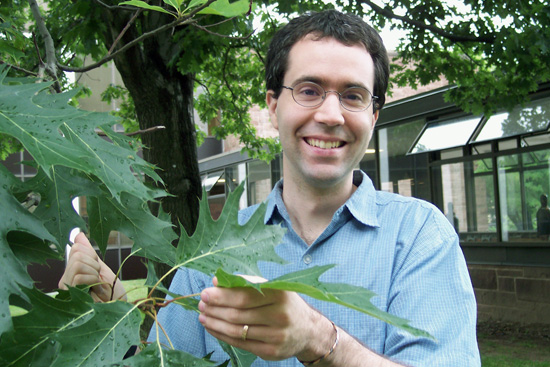Assistant Professor Joins Earth and Environmental Sciences Department
 |
| Dana Royer, assistant professor of earth and environmental sciences, studies fossilized plants and plant physiology. He started at Wesleyan July 1. |
| Posted 07/13/05 |
| Dana Royer has joined the Earth and Environmental Sciences Department as an assistant professor on July 1.His professional interests include global change; paleoclimatology, paleoecology, carbon cycles, paleobotany; plant physiology and stable isotope geochemistry.
I study fossil plants in order to infer something about the paleoclimates in which they lived, as well as their paleoecologies, he says. I also study modern systems to learn more about the biological basis of these plant-environment relationships. After spending a semester studying wildlife ecology and conservation at the School for International Training in Arusha, Tanzania, Royer double majored geology and environmental studies at the University of Pennsylvania. He received a Ph.D in geology from Yale University. His thesis is titled Estimating Latest Cretaceous and Tertiary Atmospheric CO2 from Stomatal Indices, and is based on fossil leaves that infer ancient CO2 levels back to 66 million years ago. Before coming to Wesleyan, Royer worked as a research associate in the Department of Geosciences at Pennsylvania State University and as a visiting research associate at the Department of Animal and Plant Sciences at the University of Sheffield, in The United Kingdom. This fall, Royer will teach Geobiology and Introduction to Environmental Studies in the fall and Global Warming in the spring. Royer says hes most impressed by the energy in the E&ES Department, and Wesleyans solid reputation with research. I like the dual l emphasis on undergraduate teaching and cutting-edge research here at Wesleyan, he says. Most academic institutions make some claim to this, but Wesleyan delivers on both fronts better than any other institution that I know. Royer says the students also make Wesleyan an appealing institution to work. I was blown away by the students during my interview, he says. When I talk to my colleagues about Wesleyan, invariably the first point that they raise is the quality of the student body. Royer is the co-author of Correlations of climate and plant ecology to leaf size and shape: potential proxies for the fossil record, published in The American Journal of Botany, 92: 1141-1151, 2005; Contrasting seasonal patterns of carbon gain in evergreen and deciduous trees of ancient polar forests, published in Paleobiology, 31: 141-150, 2005; and CO2 as a primary driver of Phanerozoic climate change, published in GSA Today, 14(3): 4-10, 2004. He received an $80,000 grant from the Petroleum Research Fund, American Chemical Society in 2004 for his research on Why do leaves have teeth? Breakthroughs in paleoclimate analysis from biological understanding of leaf shape. The grant expires in 2006. Royer resides in Middletown with his wife, Jenny, a plant ecologist. They have a 2-year-old son, Cole, and two lazy cats. For fun, he participates in endurance sports including marathons, ultramarathons and bicycling. |
| By Olivia Drake, The Wesleyan Connection editor |

